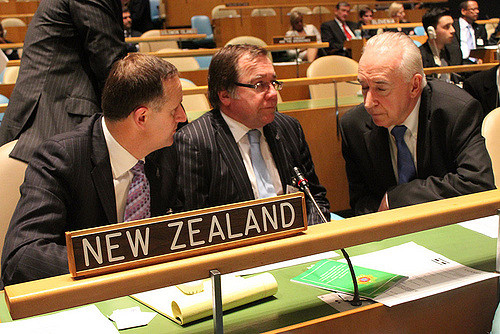Many aid and development advocates aim for policy change in some shape or form. In this and two following posts I summarise the findings from my doctoral research in which I explored the question: how does donor aid policy change? Each of the three posts correspond to what I found about the actors, ideas and rules involved in two significant New Zealand (NZ) aid policy changes. My findings offer insights for people who wish to change aid policy or protect the status quo.
What I discovered was that important to aid policy goal changes were individuals behaving entrepreneurially, connected to an ideas-based network, within a web of rules that simultaneously constrained actors while actors manoeuvred amongst the rules. In this first post, I define change, then detail what I mean by ‘individuals behaving entrepreneurially’. In the second post I discuss the ideas-based network, focusing on the ideas that brought actors together. I wrap-up in the third post, exploring how the rules come into play, and discuss the findings’ implications.
Because change is an extraordinarily complex, multifaceted phenomena, any change analysis must first clearly define ‘change’. In my research, I explored two aid policy goal changes. These goal changes involved shifts in the high-level ideas governing aid policy: what a donor government’s aid should be spent to achieve and how. The table below summarises the two NZ changes I explored.
Individuals were key change drivers in both NZ aid policy goal changes: individuals exhibiting particular behaviours. Policy scholars have grouped and labelled these behaviours as ‘entrepreneurial’ (Kingdon 2011; Mintrom and Norman 2009 [paywalled]; Ackrill and Kay 2011 [paywalled]). In the two NZ policy goal changes, three individuals clearly displayed entrepreneurialism: Pat Webster, the Council for Development’s (CID) Executive Director (1994-2001); David Shearer, Ministerial Advisor to the Minister of Foreign Affairs and Trade (2000-2002); and National Party opposition spokesperson on foreign policy, Murray McCully, who subsequently became the Minister of Foreign Affairs from 2008 to 2017.
These three individuals fit descriptions in the literature of policy entrepreneurs. They had a preferred policy goal, a reason for decision-makers to listen to them – credibility, representation or power, and they knew the system and worked it to advance their policy goal. They had relationships and used them, and built relationships where necessary to help them advance policy change. These individuals were good persuaders and could argue their case. They engaged politically first to get their policy change on the government’s agenda, but then also to drive it through to a final decision.
For example, Pat Webster knew that improving aid policy quality was a political process. She had left her Vice-Presidency role in the NZ Labour Party when joining CID, but remained active, pertinently, on the foreign affairs policy committee. Along with the Labour Party spokesperson, she wrote the Labour Party election policy on aid, including a commitment to review NZ’s aid programme. Once Labour won the election, she remained engaged, influencing key decisions as part of a network David Shearer built in his ministerial advisor position.
Shearer entered his foreign affairs ministerial advisor role after returning from humanitarian work overseas. Foreign Affairs Minister Goff tasked Shearer with managing the aid review, and while Shearer may not have begun with a strong idea about the need for aid policy change, he soon developed one. He liaised with both the Minister and Associate Minister for Foreign Affairs, and advised them on the whole process, including the type of review, who would conduct it, and uptake of the review’s recommendations. He wrote the final Cabinet papers and engaged with other ministries, such as Treasury and the State Services Commission. This work was undertaken in the face of strong opposition from the Ministry of Foreign Affairs and Trade (MFAT) to aspects of the policy goal change.
In 2009, the Foreign Affairs Minister was the key individual behaving entrepreneurially. As opposition spokesperson for foreign affairs in 2006, Murray McCully signalled his desire to develop a comprehensive foreign affairs policy manifesto, and did so. However, he did not clearly signal the aid changes that he rapidly enacted when he became minister in 2008 (a role he relinquished in May 2017).
Murray McCully is no ordinary politician. In parliament since the 1980s, he developed a reputation as a back-room operator. He was called the ‘Dark Prince’ by his colleagues, and admitted that many of them would be pleased to see him spending time offshore in his foreign affairs role. He assisted the Prime Minister, John Key, to gain the party’s leadership role and also helped several other Cabinet colleagues along the way. He was also a diligent and hard-working minister – one interviewee described him as the “energiser bunny”. Due to the fear, obligation or respect he cultivated amongst his peers, and because of his deep knowledge of the system, Minister McCully worked the rules and used his power to get his change through.
But perhaps these individuals were simply doing their job well. This raises the question: is it the role or the individual behaviour that matters most for advancing policy change? One way of answering this is to point out that there had been ministers and advisors and NGO heads before, but none had driven forward such significant aid policy goal changes.
While the roles these individuals inhabited were important – the roles gave them a right to be heard and a right to be working on the issue – so was their behaviour. If these individuals hadn’t had such a good knowledge of what they wanted to change, and how to achieve it, nothing would have happened. What was required was a combination of the role, and the individual’s entrepreneurial behaviour in that role. Yet, these individuals could not act alone and were part of ideas-based networks, as I discuss in my next post.
Jo Spratt is an ANU PhD candidate studying NZ aid policy. This post is the first in a three-part series based on her PhD thesis; read part two here.



Leave a Comment